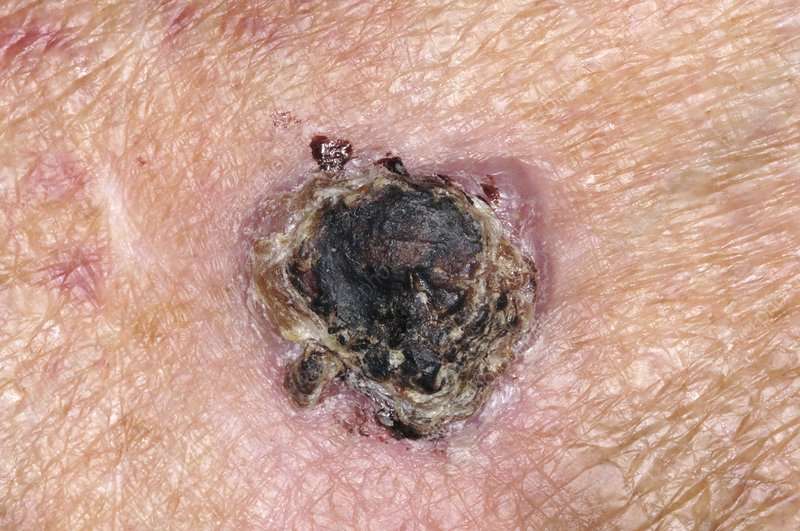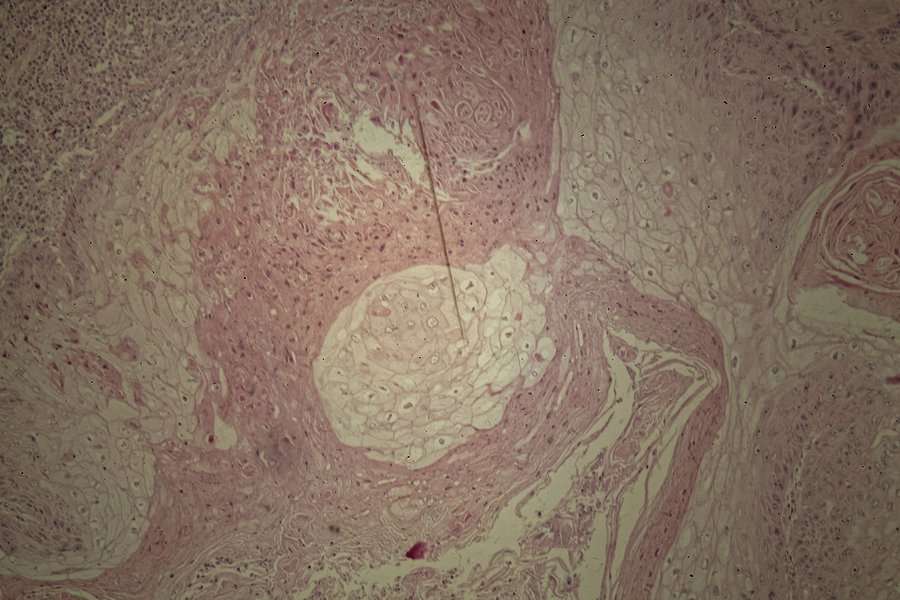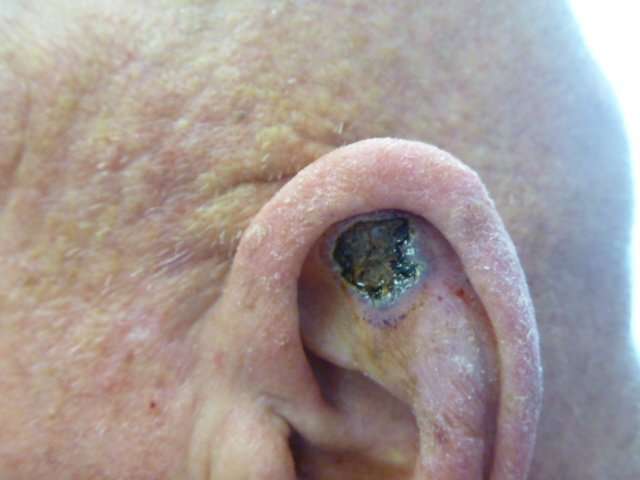The Second Most Common Skin Cancer
Squamous cell carcinoma of the skin is the second most common form of skin cancer, characterized by abnormal, accelerated growth of squamous cells. When caught early, most SCCs are curable.
SCC of the skin is also known as cutaneous squamous cell carcinoma . Adding the word cutaneous identifies it as a skin cancer and differentiates it from squamous cell cancers that can arise inside the body, in places like the mouth, throat or lungs.
Squamous Cell Skin Cancer Of The Head And Neck Treatment
Surgery is the preferred management method for the majority of squamous cell skin cancers. Low-risk, early stage, small squamous cell cancers can be removed by Mohs surgery, which is a technique that spares normal tissue through repeated intraoperative margin testing, removing only the cancer and leaving adjacent normal tissue. Excision, curettage and desiccation, and cryosurgery can also be used to remove the cancer while sparing normal tissue. Radiation alone is an alternative for low-risk tumors when surgery is not desirable because of cosmetic concerns or medical reasons.
Large tumors and tumors with nerve or lymph node involvement are not suitable for Mohs surgery and require removal of at least 5-millimeter margins of normal tissue around the cancer and neck dissection for involved lymph nodes. Larger tumors require reconstruction, which can be done at the time of surgery if margin status is clear. Reconstruction should be staged when margins status is not clear.
Patients with high-risk tumors should meet with a radiation therapist to discuss postoperative radiation. Chemotherapy may be added to radiation for extensive lymph node involvement or positive margins that cannot be cleared with additional surgery. In patients with high-risk tumors who are not surgical candidates, systemic treatment with both radiation and chemotherapy is used. Such cases require multidisciplinary care by a team of surgeons, radiation oncologists and medical oncologists.
Squamous Cell Carcinoma Can Kill
Numbers in the UK are lower than the US due to population size but the basic message is the same, melanoma is not the only deadly skin cancer.
We dont want you to worry in one sense, the chances of squamous cell carcinoma spreading to lymph nodes, or other organs is much lower than malignant melanoma. This is however balanced by a far higher incidence.
There are around 150,000 documented UK skin cancer cases each year and over 20% are SCCs, which account for most non melanoma fatalities. There is also a notable trend for all non melanoma skin cancers:
Improved detection and treatment had seen fatalities consistently fall for 30 years until the trend turned around 2001. We are now back to the position about 40 years ago and whilst population increase plays a part, so does greater incidence.
A combination of lifestyle changes and holidays in the sun over decades has caught up with us. Treatment has continued to improve and digital technology helps with detection but we are not entirely winning the battle.
Also Check: Does Skin Cancer It H
Who Gets Cutaneous Squamous Cell Carcinoma
Risk factors for cutaneous SCC include:
- Age and sex: SCCs are particularly prevalent in elderly males. However, they also affect females and younger adults.
- Previous SCC or another form of skin cancer are a strong predictor for further skin cancers.
- Previous cutaneous injury, thermal burn, disease
- Inherited syndromes: SCC is a particular problem with xeroderma pigmentosum, albinism, and epidermodysplasia verruciformis
- Other risk factors include ionising radiation, exposure to arsenic, and immune suppression due to disease or medicines. Organ transplant recipients have an increased risk of developing SCC.
Diagnosing Squamous Cell Carcinoma

The main way to diagnose squamous cell carcinoma is with a biopsy. This involves having a small piece of tissue removed from the suspicious area and examined in a laboratory.
In the laboratory, a pathologist will examine the tissue under a microscope to determine if it is a skin cancer. He or she will also stage the cancer by the number of abnormal cells, their thickness, and the depth of penetration into the skin. The higher the stage of the tumor, the greater the chance it could spread to other parts of the body.
Squamous cell carcinoma on sun-exposed areas of skin usually does not spread. However, squamous cell carcinoma of the lip, vulva, and penis are more likely to spread. Contact your doctor about any sore in these areas that does not go away after several weeks.
Don’t Miss: What Is The Best Hospital For Melanoma
How Do Dermatologists Diagnose Squamous Cell Carcinoma Of The Skin
Because this cancer begins on the skin, its possible to find it early when its highly treatable.
When you see a board-certified dermatologist, your dermatologist will examine your skin carefully.
If your dermatologist finds a spot on your skin that could be any type of skin cancer, your dermatologist will first numb the area and then remove all of it. This can be done during an office visit and is called a skin biopsy. This is a simple procedure, which a dermatologist can quickly, safely, and easily perform.
Having a skin biopsy is the only way to know for sure whether you have skin cancer.
What your dermatologist removes will be examined under a high-powered microscope. Your dermatologist or a doctor who has in-depth experience diagnosing skin growths, such as a dermatopathologist, is best qualified to examine the removed tissue under a microscope.
After examining the removed tissue, the doctor writes a biopsy report. Also called a pathology report, this report explains what was seen under the microscope, including whether any skin cancer cells were seen.
If you have squamous cell carcinoma of the skin, the report will contain the following information when possible:
-
Type of SCC
-
Whether the cancer has any features that make it aggressive
How Is Squamous Cell Carcinoma Of The Skin Treated When It Spreads
When this cancer spreads beyond the skin, it travels to the lymph nodes or other organs. Once it spreads, a patient has advanced cancer.
If you’ve been diagnosed with advanced SCC, you will be cared for by a team of medical professionals. This team will include oncologists . Your treatment plan may include one or more of the following:
Surgery: When surgery can remove the cancer and youre healthy enough to have surgery, this is often the preferred treatment. After surgery, another treatment, such as radiation therapy or chemotherapy, is often given. Adding another treatment helps to kill cancer cells.
Radiation therapy: Radiation can target cancer cells in the skin, lymph nodes, or other areas of the body. When a patient has advanced SCC, radiation therapy is often used along with another treatment.
Immunotherapy: This type of treatment helps strengthen your immune system so that it can fight the cancer. Drugs called immunotherapy medications are given for this purpose.
The U.S. Food and Drug Administration has approved one immunotherapy medication for the treatment of advanced SCC of the skin. Its called cemiplimab-rwlc.
In the clinical trials that led the FDA to approve cemiplimab-rwlc, about half the patients who had advanced SCC of the skin had their tumors shrink. In many patients who had tumor shrinkage, the shrinking lasted 6 months or longer. A few patients had their tumors disappear completely.
Immunotherapy
Pembrolizumab is also given by IV infusion.
Read Also: How Do You Know If You Have Melanoma
What Is The Life Expectancy For Squamous Cell Carcinoma
The prognosis for squamous cell skin cancers is generally good, and death is rare. When the cancer is detected at an earlier stage, it can often be cured.When squamous cell carcinoma has spread to nearby lymph nodes, it still may be treated with a combination of surgery and radiation.
Recurrence of squamous cell carcinoma is possible and it is important to follow-up and see a dermatologist regularly to increase the chances of early detection and treatment.
Factors That Could Affect Your Prognosis
Certain aspects of your health or cancer could affect your outlook. For example, people who have a weakened immune system from a disease like HIV or a medication they take tend to have a less positive outlook.
The location of the tumor also matters. Cancers on the face, scalp, fingers, and toes are more likely to spread and return than those on other parts of the body. SCC that starts in an open wound is also more likely to spread.
Larger tumors or ones that have grown deep in the skin have a higher risk of growing or returning. If a cancer does recur after treatment, the prognosis is less positive than it was the first time around.
Ask your doctor if you have any risk factors that can be managed or controlled. You may need more aggressive treatment, or to be monitored more closely for recurrence.
You May Like: How Quickly Can Melanoma Appear
Key Points On Squamous Cell Carcinoma
From The Harvard Health Letter May 2006
Summers the season for fun in the sunbut also for skin cancer. Of the three main types of skin cancer, melanoma is most deadly, and basal cell, most common. Squamous cell cancer falls in between. Its three times as common as melanoma . Though not as common as basal cell , squamous cell is more serious because it is likely to spread . Treated early, the cure rate is over 90%, but metastases occur in 1%5% of cases. After it has metastasized, its very difficult to treat.
Don’t Miss: How Do You Test For Melanoma
How Serious Is A Squamous Cell Carcinoma Topic Guide
Squamous Cell Carcinoma Stages

There are certain features that are considered to make the cancer at higher risk for spreading or recurrence, and these may also be used to stage squamous cell carcinomas. These include:
- Greater than 2 mm in thickness
- Invasion into the lower dermis or subcutis layers of the skin
- Invasion into the tiny nerves in the skin
- Location on the ear or on a hair-bearing lip
After the TNM components and risk factors have been established, the cancer is assigned to one of the five squamous cell carcinoma stages, which are labeled 0 to 4. The characteristics and stages of squamous cell cancer are:
Stage 0: Also called carcinoma in situ, cancer discovered in this stage is only present in the epidermis and has not spread deeper to the dermis.
Stage 1 squamous cell carcinoma: The cancer is less than 2 centimeters, about 4/5 of an inch across, has not spread to nearby lymph nodes or organs, and has one or fewer high-risk features.
Stage 2 squamous cell carcinoma: The cancer is larger than 2 centimeters across, and has not spread to nearby organs or lymph nodes, or a tumor of any size with 2 or more high risk features.
Stage 3 squamous cell carcinoma: The cancer has spread into facial bones or 1 nearby lymph node, but not to other organs.
Stage 4 squamous cell carcinoma: The cancer can be any size and has spread to 1 or more lymph nodes which are larger than 3 cm and may have spread to bones or other organs in the body.
You May Like: How To Stop Skin Cancer
What Are Symptoms Of Squamous Cell Carcinoma
Squamous cell carcinoma tends to develop on sun-exposed areas of the body such as the face, lips, ears, scalp, neck, shoulders, backs of the hands, and forearms, though it may occur anywhere on the skin.
Characteristics of squamous cell carcinomas include:
- Raised growths or lumps, which may be depressed in the center
- Rough or scaly red patches, which may crust or bleed
- Open sores that may ooze or crust over, dont completely heal, or that heal and return
- A flat area only slightly different from normal skin
Types Of Skin Cancer Squamous Cell Carcinoma : Dermoscopic Findings In Cutaneous Metastases
There are a number of different treatments doctors recommend. To help care for your skin during the coronavirus pandemic and beyond, the aad recommends these tips fro. It may grow slowly and it’s typically treatable. In the united states, it’s estimated that doctors diagnose over 100,000 new skin cancer cases each year. Skin cancer is the most common type of cancer in the united states, with basal and squamous cell skin cancer being the most common carcinoma types.
Don’t Miss: How Fast Can Melanoma Spread
Types Of Cutaneous Squamous Cell Carcinoma
Distinct clinical types of invasive cutaneous SCC include:
- Cutaneous horn the horn is due to excessive production of keratin
- Keratoacanthoma a rapidly growing keratinising nodule that may resolve without treatment
- Carcinoma cuniculatum , a slow-growing, warty tumour on the sole of the foot
- – a cutaneous SCC that has developed in a scar or chronic ulcer
- Multiple eruptive SCC/KA-like lesions arising in syndromes, such as multiple self-healing squamous epitheliomas of Ferguson-Smith and Grzybowski syndrome
The pathologist may classify a tumour as well differentiated, moderately well differentiated, poorly differentiated or anaplastic cutaneous SCC. There are other variants.
Subtypes of cutaneous squamous cell carcinoma
What Makes Yale Medicines Approach To Squamous Cell Carcinoma Unique
Simple, small cancers can often be treated very well by a local dermatologist, according to Dr. Leffell. We rarely see the small cancers. We get referred to the cases that need special attention.
Dr. Leffell emphasizes that at Yale Medicine, the patient always comes first. We like to have a discussion with the patient about what happens after the skin cancer is removed, he says. We talk about what’s involved with plastic surgery and what’s involved with letting the area heal naturally. We prefer to take a minimalist approach and let the patient decide what they want us to do and how they want to let their skin heal.
If the decision is made to repair the wound using plastic surgery, we do that immediately in the office setting, Dr. Leffell says. Alternatively, allowing the wound to heal naturally is often a great option, and does not rule out doing plastic surgery down the road if needed, though that is very rarely the case.
Recommended Reading: Is Basal Cell Carcinoma Malignant
What Are The Symptoms Of Squamous Cell Skin Cancer
Squamous cell cancers are usually raised growths, ranging from the size of a pea to the size of a chestnut. They may appear as scaly red patches, open sores or protruding growths with a dented center, or they may look like a wart. Most are found in areas of the body that are frequently exposed to the sun, such as the ears, lips, face, balding scalp, neck, hands, arms, and legs. Less commonly, they may appear on mucous membranes and genitals. Regardless of what form the bumps take, they do not heal or go away on their own.
To Help Care For Your Skin During The Coronavirus Pandemic And Beyond The Aad Recommends These Tips Fro
Lung cancer has two broad types: When cancerous tumors form on connective tissues, it is a sarcoma. In the united states, it’s estimated that doctors diagnose over 100,000 new skin cancer cases each year. The strongest risk factor for developing skin cancer is ultraviolet ray exposure, typically from the sun. But too much fun without protecting your skin from harmful uv rays from the sun can, unfortunately, lead to the development of basal cell carcinoma the most common, but least dangerous of th. Adenocarcinoma cancers being usually in one of the following organs: It may grow slowly and it’s typically treatable. It affects people of all races, genders and ages, which is why it’s absolutely critical for americans to learn about. The general term “lung cancer” actually covers a few very different versions of the disease. According to the american cancer society, just over 100,000 new cases of skin cancer are diagnosed in the united states each year. Prostate cancer is a common type of cancer in men, according to the mayo clinic. To help care for your skin during the coronavirus pandemic and beyond, the aad recommends these tips fro. If you have been diagnosed with adenocarcinoma cancer, you have a cancer that developed in one of the glands that lines the inside of your organs.
Read Also: How To Tell If You Have Skin Cancer
What Are Basal And Squamous Cell Skin Cancers
Basal and squamous cell skin cancers are the most common types of skin cancer. They start in the top layer of skin , and are often related to sun exposure.
Cancer starts when cells in the body begin to grow out of control. Cells in nearly any part of the body can become cancer cells. To learn more about cancer and how it starts and spreads, see What Is Cancer?
How Common Is Squamous Cell Carcinoma

Over 1 million people are diagnosed with SCC in the US each year. The incidence of SCC has risen about 200 percent over the past 30 years. There are more than 15,000 deaths each year in the US from SCC. Excluding head and neck SCC and CSCC in situ, about 200,000-400,000 new cases of SCC are diagnosed in the US every year, resulting in about 3,000 deaths.
Men are about two times more likely than women to develop SCCs. People over the age of 50 are most likely to get SCCs, but the incidence has been rising in younger people.
Recommended Reading: What Is Melanoma In The Brain